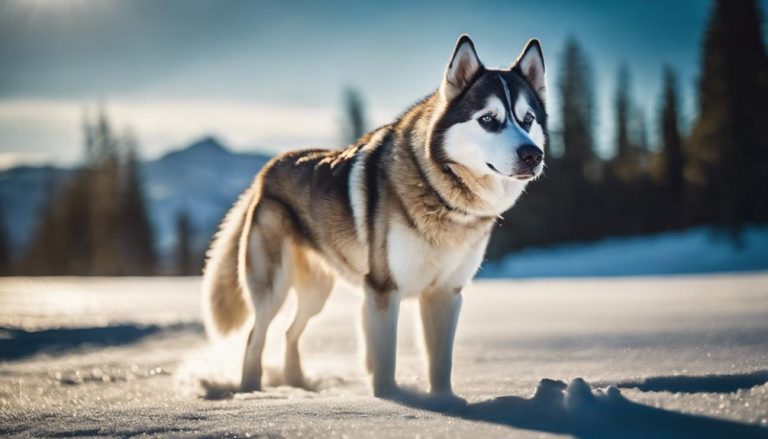Alaskan Husky: Breed Overview and Characteristics
The Alaskan Husky is a blend of North American and Siberian dogs, designed for endurance and speed, making them perfect for sled racing. These dogs are medium to large, standing 17-25 inches tall and weighing between 35-65 pounds. They have a thick, double-layer coat that protects them from cold weather.
Alaskan Huskies are known for their stamina, reaching speeds of up to 28mph. It’s important to be aware of genetic conditions like Alaskan Husky Encephalopathy, and they need a lot of exercise to stay healthy. A good diet and regular grooming are essential for their care.
Looking into their ability to adapt and their historical role shows a deep connection between these dogs and their human partners.
Key Takeaways
- Alaskan Huskies are bred for sled pulling, showcasing strength and speed.
- These dogs bond closely with their handlers and thrive on teamwork.
- Health risks like Alaskan Husky Encephalopathy require DNA tests for prevention.
Quick Facts
The Alaskan Husky stands out for its medium to large size, boasting a strong build. It has a thick, double coat that comes in colors like black, white, brown, and gray. This coat is crucial for insulation in cold weather, making these dogs perfect for sled pulling. They have a height range of 17-25 inches and weigh between 35-65 pounds, a balance of strength and agility that’s vital for their job.
When it comes to personality, Alaskan Huskies are known for being lively, smart, loyal, and loving. These characteristics, along with their natural stamina and endurance, make them great partners for both work and home life. Breeders focus on their genetic health to ensure they live long and healthy lives, typically around 10-15 years. Keeping these dogs healthy and happy is a priority, especially given their role as working sled dogs and adaptable family pets.
Overview
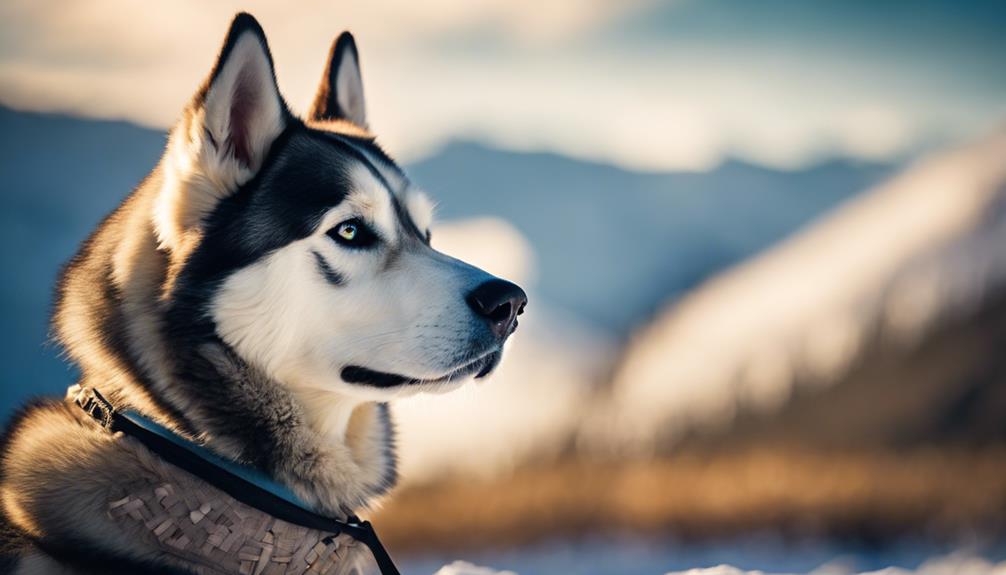
Alaskan Huskies are the result of specialized breeding, focusing on their remarkable ability to navigate sled races with incredible speed and strength. These dogs showcase the power of genetics in creating animals that are not just strong but also adaptable to different environments. Despite not being officially recognized by kennel clubs, Alaskan Huskies carry a unique genetic identity that makes them stand out. They are bred to excel in pulling sleds, capable of carrying loads much heavier than themselves and reaching speeds of up to 28mph in races.
These dogs come from a lineage that combines pre-Colonial North American Arctic village dogs with Siberian breeds, giving them a taller and lighter physique than Siberian Huskies and Alaskan Malamutes. This genetic mix contributes greatly to their agility and endurance in tough conditions. Their ability to adapt to various climates and terrains is largely due to their diverse genetic background, which is specifically tailored for sled dog racing.
Alaskan Huskies are known for their friendly nature and their ability to work closely with humans, making them ideal for team activities. Their intelligence and eagerness to learn make them highly trainable, fostering a strong bond between the dogs and their mushers. This relationship is crucial for both the dogs’ performance in races and their overall well-being, showing that proper training is key.
Sled Racing Champions
Alaskan Huskies are at the top of their game in sled racing competitions like the Iditarod and Yukon Quest. These events push dogs to their limits in terms of endurance, speed, and teamwork. Alaskan Huskies thrive here because they’ve been bred for the strength and stamina needed to excel under tough racing conditions.
The connection between the mushers and their Alaskan Huskies is crucial. It’s all about working together, keeping an eye on each other’s health, and respecting the bond that helps them tackle the harsh conditions they face. This relationship is key not just for winning but also for making sure the dogs stay healthy and happy throughout the race.
| Aspect | Why It Matters in Sled Racing |
|---|---|
| Endurance | It’s what keeps the dogs going over long distances. |
| Speed | It gives teams an edge over others in the competition. |
| Teamwork | It’s needed to navigate through challenging terrains. |
| Health Focus | It ensures dogs stay in top shape, physically and mentally. |
These factors show why Alaskan Huskies are unmatched in sled racing. Their ability to keep going, their quickness, how well they work as a team, and the attention their mushers pay to their health, make them stand out.
Sled Dog Origins
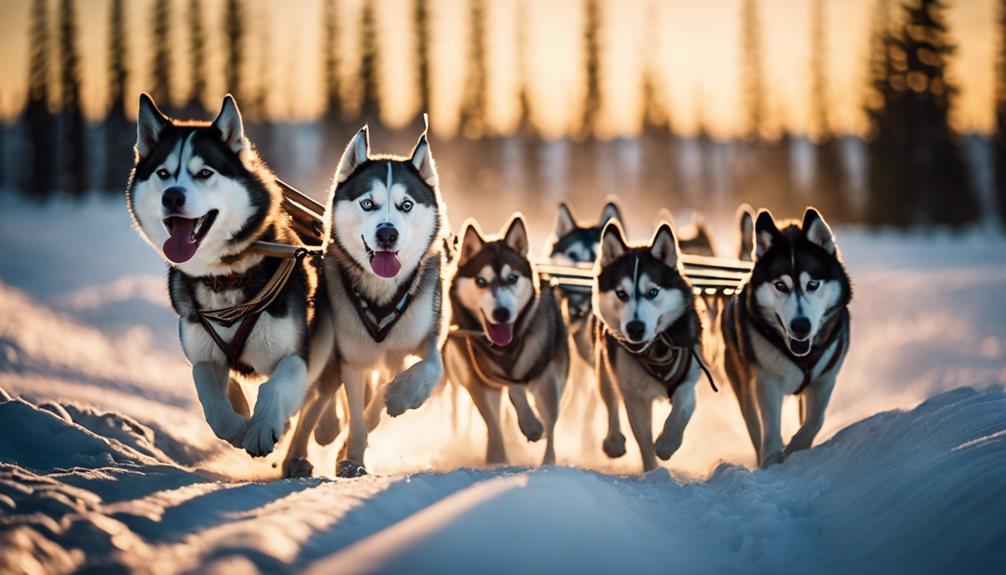
The Alaskan Husky has a deep history rooted in its beginnings within Arctic communities, evolving into a star of modern sled dog racing. This breed has been meticulously crossbred to improve its speed, endurance, and ability to withstand cold environments, showing a deep understanding of dog genetics and physical needs. Over time, training methods have been fine-tuned to ensure these dogs not only excel in races but also maintain their health.
- Racing’s Rich History: Transitioning from necessity to sport, this section shines a light on influential figures and milestone races in the world of sled dog racing.
- Breed Evolution: This part breaks down how mixing genes from different breeds has shaped the Alaskan Husky’s abilities and personality, making it the perfect sled dog.
- Modern Training: Here, we look at current training strategies designed to push the breed’s athletic limits while prioritizing their health and happiness.
The Alaskan Husky’s journey from a vital work animal to a celebrated racing breed showcases not just the adaptability and resilience of these dogs but also the human dedication to refining and caring for their canine companions. As we continue to learn and grow with them, these dogs remain a testament to the rich history and exciting future of canine athleticism and companionship.
History of Racing
Sled dog racing, once a necessary mode of transport in the arctic regions, has transformed into a thrilling sport. This change started in the early 20th century, turning sled dog racing into more than just a form of travel.
The Iditarod Trail Sled Dog Race stands as the most famous event in this sport, showing off the incredible endurance and speed of Alaskan Huskies across long distances. These dogs are not only good at long races but also excel in shorter sprints, reaching speeds of up to 28mph.
Their remarkable speed and endurance come from careful breeding and intense training, making them stars in the world of sled dog racing.
Breed Evolution
The Alaskan Husky has a rich history that stretches back to the pre-Colonial North American Arctic village dogs and Siberian imports. These early dogs gave the Alaskan Husky the necessary traits for surviving and thriving in cold climates. Breeders later mixed in Old World breeds to improve speed and endurance, a process that was accelerated with the rise of sport sled dog racing.
This focus on physical performance and resilience led to the inclusion of genetic material from European breeds like Pointers and German Shepherd Dogs. This genetic diversity played a significant role in shaping the Alaskan Husky’s abilities, making them a staple in sled dog racing today. The combination of village dogs and European breeds has ensured that the Alaskan Husky remains closely related to the Siberian Husky and Alaskan Malamute, guaranteeing their health and vitality in the demanding world of sled dog racing.
Training Techniques
Alaskan Huskies are bred for sled pulling, and their training focuses on their natural strengths. This includes building teamwork, improving endurance, and teaching obedience essential for their work. Their training routines are carefully crafted to bring out their best instincts for pulling sleds. Trainers work on creating a strong working relationship within the team from when the dogs are young. This involves using positive methods to encourage good behavior. Such an approach strengthens the bond between dogs and their handlers, ensuring the dogs perform well in sled sports and activities.
Positive reinforcement is key in training Alaskan Huskies, promoting healthy and happy working dogs. Starting young, these dogs learn through routines that reward them for desired actions. This not only helps in building a strong connection with their handlers but also prepares them for top performance in their roles. The focus on their well-being and preventing injuries is crucial in their training. This ensures they can carry out their traditional roles effectively while staying healthy.
Medium to Large Build
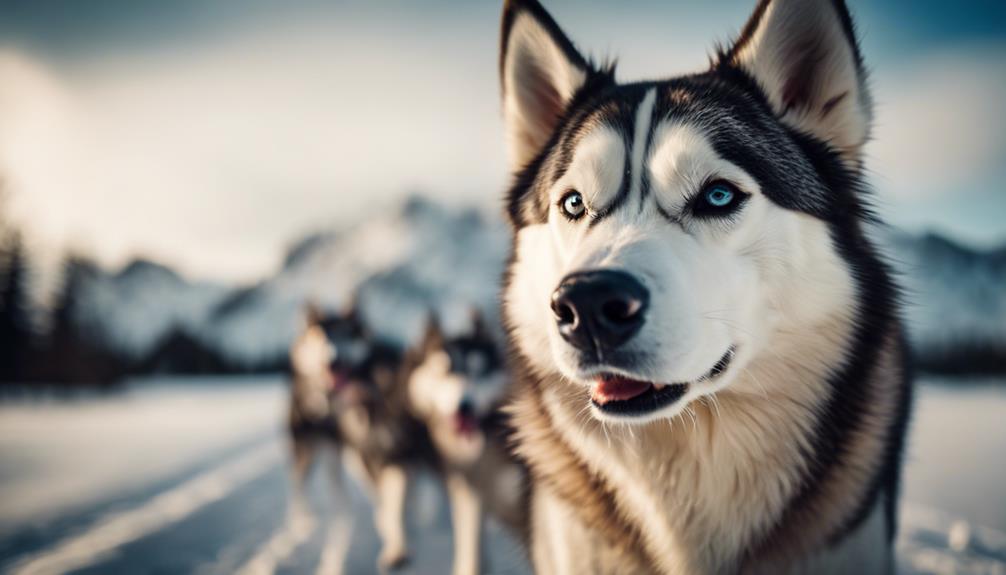
The Alaskan Husky has a build that ranges from medium to large, making it a versatile and enduring breed for various activities. Its size and weight are crucial in understanding how to care for it properly, from the type of exercise it needs to its dietary requirements. These factors also determine how well the dog will perform in work settings or as a family pet. The physical traits of the Alaskan Husky, including its height and the breed’s variability, are key to its overall health and happiness. They impact everything from how much activity the dog needs to its risk for certain health issues.
Size range is critical for creating a tailored exercise and meal plan for your pet. Weight category plays a significant role in preventing obesity-related diseases and forming strategies for maintaining a healthy weight. The breed’s physical characteristics can influence joint health and the likelihood of inherited conditions like hip dysplasia.
Understanding these aspects helps in providing the best care for an Alaskan Husky, ensuring they lead a healthy, active life.
Size Range
Alaskan Huskies stand 17 to 25 inches tall at the shoulder and weigh between 35 to 65 pounds.
This size range makes them perfect for demanding activities like sled pulling, where strength and endurance are key.
Their medium to large build isn’t just about looks; it’s essential for their work in tough conditions.
These dogs have the muscle and agility needed to move through difficult landscapes effectively.
Their physical form is specially designed for stamina, allowing them to excel in long-distance runs and sled races.
The size and strength of an Alaskan Husky are critical for their health, their ability to perform well in various tasks, and their enjoyment of outdoor activities, making them reliable and adaptable partners.
Weight Category
The weight range of 35-65 pounds significantly enhances the physical and athletic abilities of Alaskan Huskies as sled dogs. At this weight, they strike a perfect balance between strength and stamina, which is crucial for the challenging nature of sledding.
Their size enables them to haul heavy loads over long distances, while still maintaining a swift pace and nimbleness. This optimal weight is key to their impressive power-to-weight ratio, making them highly efficient and effective in demanding physical activities.
Keeping these dogs in top health and at an ideal weight is vital for their success in endurance races and sledding, highlighting their extraordinary athletic skills.
Build Characteristics
Alaskan Huskies are known for their medium to large size, with a height ranging from 17 to 25 inches and a weight of 35 to 65 pounds. This sturdy build plays a key role in their overall health and athletic abilities.
They have a dense double coat that comes in colors like black, white, brown, or gray, which not only shields them from extreme weather but also shows how well they adapt to different environments.
These dogs stand out for their energetic, smart, faithful, and loving nature, making them versatile companions. Their physical traits and personality contribute to their general well-being, allowing them to live for about 10 to 15 years.
It’s crucial to give them the right training and enough physical activity to tap into their potential while keeping them healthy and content.
Typical Height
With a height ranging from 17 to 25 inches at the shoulder, Alaskan Huskies are notably medium to large dogs. This size is not just a number; it tells the story of their development into top-notch working dogs. Their build makes them perfect for tasks like sled pulling, allowing them to travel long distances over difficult terrains with ease.
Their size is a big part of why they’re so good at what they do, contributing to their strength, endurance, and overall performance in challenging conditions. For Alaskan Huskies, being the right height is key to thriving in tough climates, showcasing their breed’s focus on athleticism and practicality.
Breed Variability
The Alaskan Husky stands out due to its size and build variability, with weights ranging from 35 to 65 pounds. These dogs can be anywhere from 17 to 25 inches tall, equipped with a dense, double coat that protects them in cold climates. Their coat comes in various shades like black, white, brown, and gray. This range in appearance and size highlights the breed’s mixed ancestry and the targeted breeding to enhance their work abilities.
Alaskan Huskies are not just skilled sled dogs but also great pets, combining energy, intelligence, loyalty, and affection. This makes them ideal for active people or families looking for a dog that can keep up with their lifestyle.
Loyal and Energetic
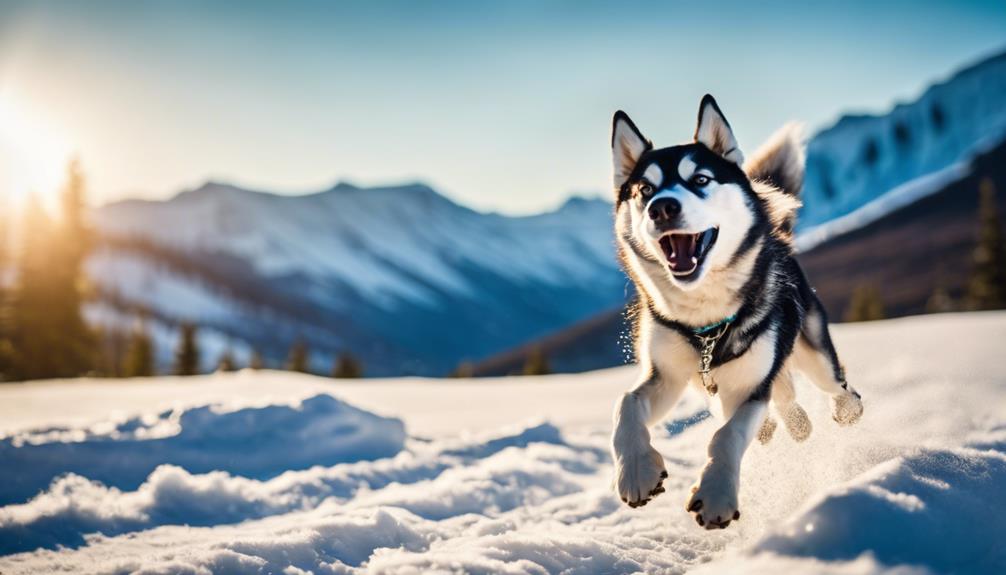
Alaskan Huskies are known for their deep loyalty and immense energy, traits that make them unique but also require owners to have a good grasp of their care needs. These dogs are naturally inclined towards activities that need endurance and quickness, affecting how they should be trained and interacted with. For their physical and psychological health, it’s critical to have a routine that includes exercise, mental stimulation, and regular health check-ups.
Energy Levels Unpacked: The high energy of Alaskan Huskies means they need daily, intensive workouts to avoid getting bored and acting out. Keeping them physically active helps manage their energy and prevents unwanted behavior.
Training Tips for Energetic Huskies: Training these energetic and smart dogs requires patience and understanding of their independent nature. Finding ways to engage their minds while training can make a big difference in their learning process.
Health and Activity Guidelines: It’s essential to keep up with their health screenings and tailor their diet to suit their active lifestyle. Mental challenges are just as important as physical exercise to keep them interested and happy.
Husky Loyalty Traits
Alaskan Huskies are known for their strong loyalty and the deep connection they share with their families. They are full of energy, which makes them great partners for activities that involve teamwork. These dogs are not just friendly; they thrive on human interaction, which makes them excellent companions and workers. When it comes to tasks like sledding and racing, their dedication and hard work really shine through.
Their sociable nature means they get along well with people, further proving their loyalty. Alaskan Huskies are also physically strong, allowing them to perform well in demanding roles. This combination of emotional and physical strength makes them reliable and loving partners in both work and play.
Energy Levels Explored
Alaskan Huskies are known for their endurance and agility, thriving on high-energy activities. These dogs need daily, vigorous exercise to stay healthy and well-behaved. Their heritage is rooted in tasks that require speed and stamina, such as sled pulling and racing, making them perfect for active individuals or families.
Engaging Alaskan Huskies in physical and mental activities is key to managing their energy. This approach ensures they remain loyal, physically fit, and mentally sharp.
Training Energetic Huskies
Training energetic Huskies is all about channeling their natural loyalty and energy in the right direction. These dogs need regular and consistent exercise to stay healthy and happy. Activities like long runs or agility courses are perfect to keep them physically fit and mentally sharp. This helps prevent any bad behaviors that come from too much unused energy.
Using positive reinforcement during training plays to their smart and responsive nature. This approach makes learning a positive experience for them and helps them pick up on what’s expected quickly. Obedience classes and mental exercises, like puzzle toys, are great for making sure your Husky knows the rules. This kind of training not only helps your dog but also strengthens your bond, making it a rewarding journey for both of you.
Social Behaviors
Alaskan Huskies are known for their loyalty and endless energy, making them perfect for people who love to stay active. These dogs bond closely with their humans, becoming key members of their families or groups. They need lots of exercise and enjoy being part of outdoor adventures like running, hiking, and dog sports.
Their social nature means they thrive on interaction. Keeping them involved in various activities is crucial for their well-being. This mix of loyalty and vitality makes them ideal companions for those with an adventurous spirit.
Health & Activity Needs
Ensuring the health and happiness of an Alaskan Husky means keeping up with their exercise and mental stimulation needs. These dogs are naturally athletic and need regular exercise to stay fit and avoid gaining too much weight, which can lead to health problems. Keeping them active and mentally engaged prevents naughty behaviors that come from being bored. They love being outdoors and doing different kinds of activities.
It’s crucial to have a care routine that includes plenty of exercises and challenges to keep their minds sharp. This approach helps Alaskan Huskies stay loyal and full of energy, leading to a joyful and healthy life for them.
Genetic Conditions Awareness
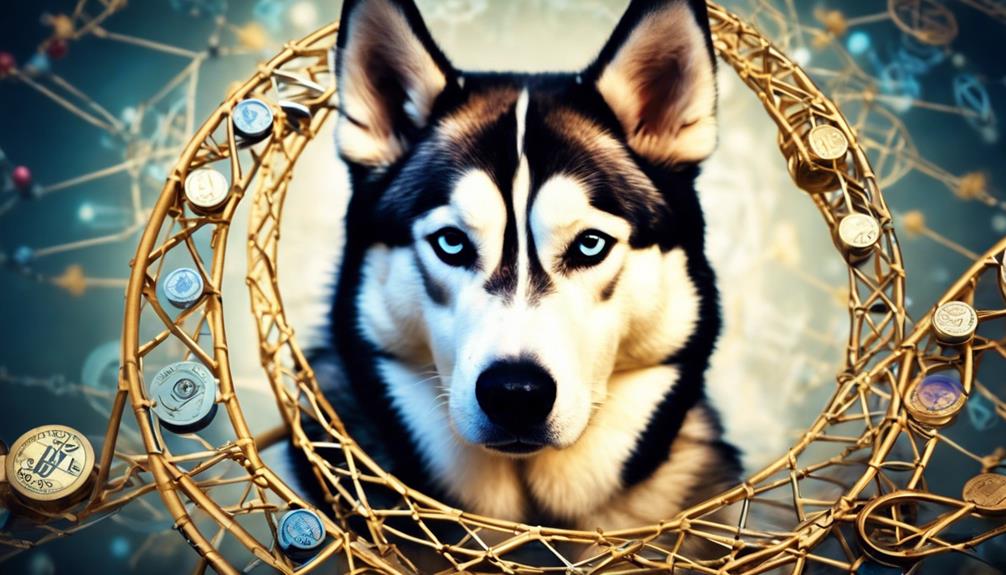
Understanding the health risks specific to Alaskan Huskies is key to safeguarding their health and ensuring they lead long, happy lives. Through DNA tests, such as those provided by Wisdom Panel™ Premium, we can uncover information on more than 200 genetic conditions. This knowledge allows for the early identification and care of diseases like Alaskan Husky Encephalopathy and Degenerative Myelopathy, which can significantly improve the lives of these dogs.
Genetic health risks for Alaskan Huskies include breed-specific issues like Alaskan Husky Encephalopathy and Degenerative Myelopathy. These conditions affect the nervous system and mobility, respectively. DNA testing gives us a way to find out if a dog might develop these issues, helping to plan ahead for their care. With the right care plan, which combines advice from veterinarians and tailored support, Alaskan Huskies with genetic health risks can enjoy better quality of life.
Understanding and managing genetic conditions in Alaskan Huskies is all about catching potential health issues early and adapting care to meet their specific needs. This proactive approach not only helps in managing existing conditions but also in preventing the development of others, ensuring a healthier, happier life for these beautiful dogs.
Genetic Health Risks
It’s vital for anyone considering adding an Alaskan Husky to their family to be aware of certain health risks that are common in the breed. A key issue to watch out for is Alaskan Husky Encephalopathy, a serious brain condition that affects the dog’s ability to process certain nutrients. Dogs with this disorder may experience seizures, act differently than usual, and have trouble moving properly. Catching such issues early can make a big difference.
Another major concern is Degenerative Myelopathy, which tends to strike in the later years of a dog’s life. This condition gradually worsens the dog’s control over its back legs due to spinal cord deterioration. It’s a reminder that senior dogs need specific care and attention. Responsible breeders test for these and other conditions, like lysosomal storage disease and hypothyroidism, to ensure their puppies are as healthy as possible.
Staying informed and seeking regular vet check-ups can help Alaskan Husky owners maintain their pet’s health and happiness.
DNA Testing Insights
DNA testing is crucial for managing health risks in Alaskan Huskies. It can detect over 200 genetic health conditions through products like Wisdom Panel™ Premium, helping owners and breeders prepare for potential health issues.
Tests can uncover predispositions to serious ailments such as Alaskan Husky Encephalopathy and Degenerative Myelopathy, which can significantly affect a dog’s well-being if not caught early.
Wisdom Panel™ Essential offers further insights with over 25 health tests and more than 50 trait tests. This level of detail is vital for ensuring the health and performance of Alaskan Huskies through proactive care.
Care for Conditions
Understanding the genetic health of Alaskan Huskies is vital, especially when it comes to tackling conditions like Alaskan Husky Encephalopathy and Degenerative Myelopathy. These diseases significantly affect their well-being and happiness.
Wisdom Panel™ Premium offers a way to detect over 200 genetic health issues, such as lysosomal storage disease, vision problems, and hypothyroidism, paving the way for early intervention and better management of these conditions.
Knowing that Alaskan Huskies are part of the Asian and Oceanian breed group, which has its own set of genetic susceptibilities, it’s essential to customize care plans that consider these unique needs. Early and accurate genetic testing becomes a key tool in devising effective care strategies for these dogs. This ensures they enjoy healthier and more satisfying lives by addressing their specific genetic risks head-on.
Grooming Essentials
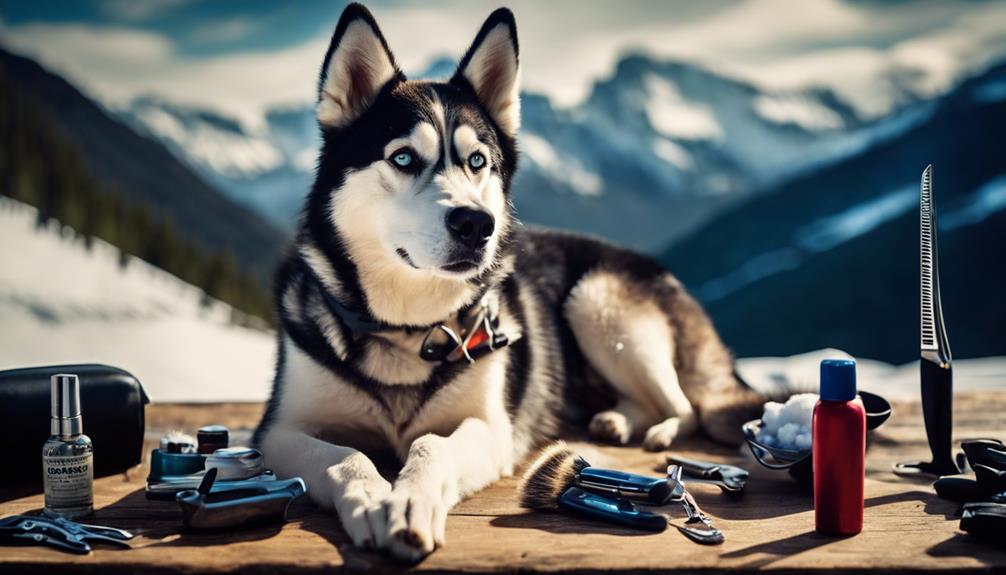
Grooming an Alaskan Husky is key to keeping them healthy, involving detailed attention to their coat, nails, and teeth. Their thick double coat and high energy levels make a consistent grooming routine essential. Regular grooming not only keeps the Husky in top shape but also strengthens the bond between pet and owner.
- Coat Maintenance: Use tools made for double-coated dogs to get rid of dead hair and avoid tangles.
- Nail Care: Set a routine for trimming nails to prevent them from getting too long, which can cause pain and make walking difficult.
- Handling Shedding: Step up the grooming game when they shed more heavily twice a year to keep their coat in good condition.
Taking care of an Alaskan Husky’s coat is crucial. Grooming tools that are made for dogs with double coats can help remove dead fur and keep matting at bay. Doing this will not only ensure their coat looks great but also supports skin health.
Keeping their nails short is another important aspect. Regular nail trimming prevents the nails from becoming too long, which can lead to discomfort and even affect how they walk. It’s a simple step that can greatly contribute to their overall comfort and mobility.
During their shedding seasons, it’s important to increase grooming efforts. This helps manage the extra fur and keeps their coat healthy. Regular brushing during these times can significantly reduce the amount of fur around the house and ensure the Husky’s coat is in prime condition.
Coat Care Basics
Taking care of an Alaskan Husky’s thick, double coat requires regular brushing to keep it free from mats. It’s also important to trim their nails, clean their ears, and look after their teeth to keep them looking and feeling their best. Their dense coats are great for insulation, especially in cold weather, which means they need a good grooming routine. Especially when they’re shedding heavily twice a year, getting rid of all that extra hair is key to managing the mess and keeping their coat in top condition.
Keeping up with these grooming tasks not only makes your Siberian Husky look great but also helps prevent skin problems and ensures their fur keeps them warm. Proper grooming is essential for their health, keeps your home hair-free, and makes your Husky happy and comfortable.
Brushing Frequency
To keep your Alaskan Husky’s coat looking and feeling its best, aim to brush it every week. The right schedule might vary depending on how long or thick your dog’s fur is. Brushing isn’t just about making their coat shiny; it’s crucial for keeping their skin healthy and preventing knots and tangles, especially in Huskies with longer fur. This grooming step also helps cut down on shedding by getting rid of dead hair, which means less fur around your house.
Regular brushing sessions are more than just coat care; they’re a chance to check your dog for any skin problems or bugs that could harm their health if left unchecked. Keeping up with brushing is key to making sure your Alaskan Husky’s coat stays strong and beautiful. It’s an essential part of keeping them healthy and happy.
Bathing Tips
For an Alaskan Husky, keeping their coat healthy involves bathing, but not too often. Only bathe your dog if they’re really dirty or smell bad. It’s crucial to use a high-quality dog shampoo to keep their skin and coat in good condition without removing vital natural oils. Their coat is made to withstand cold and wet conditions, so proper care is necessary.
Brushing your Alaskan Husky regularly helps keep their coat clean and reduces the need for frequent baths. To prevent skin and coat issues, it’s best to bathe them only every few months or when absolutely necessary. This approach helps maintain the water-resistant nature of their coat and ensures they stay healthy and comfortable.
Nail Trimming
Caring for Alaskan Huskies includes more than just managing their coat; it also means keeping their nails trimmed to avoid discomfort and movement issues. If their nails get too long, it can mess with how they walk and stand, which might hurt their joints and muscles. It’s best to clip their nails every 2-4 weeks to keep them at a comfortable length, making sure they can move easily. You have to be careful not to cut the quick, the part of the nail that has blood vessels, because it can cause bleeding and pain.
Regular nail care is crucial, not just for looks but for the health and happiness of Alaskan Huskies. Keeping their nails at the right length helps prevent pain and other problems that come from nails that are too long.
Seasonal Shedding Management
Alaskan Huskies go through significant shedding twice a year, making a solid grooming routine crucial to handle the massive fur loss. As the seasons change, these dogs shed their undercoat to stay comfortable. Regular brushing not only reduces loose fur but also helps keep their skin healthy, leading to a better coat. Including nail trimming, ear cleaning, and teeth brushing in their care ensures their overall well-being and can help avoid health issues caused by neglect.
Feeding your Husky a high-quality diet and adding the right supplements can improve the condition of their skin and fur. Grooming sessions are the perfect time to check for any skin problems, bugs, or other health concerns, allowing for quick action if something’s wrong.
Dietary Needs

Alaskan Huskies require a diet that matches their energetic lifestyle and the physical demands from their activities. It’s essential to focus on nutrition that aids in their overall health and supports their active life. A balance of high-quality protein and fats is crucial for maintaining energy and aiding muscle recovery.
Preferred diets for these dogs include high-quality commercial foods or carefully planned raw diets. These should fulfill their high energy and nutritional needs. To keep an Alaskan Husky in top shape, it’s vital to monitor their weight regularly. Adjustments in their diet and exercise routine can help avoid any unnecessary weight gain.
Ensuring these dogs have the right nutrition helps them stay healthy and ready for their physical activities. It’s about finding the right balance that suits their high-energy needs while keeping an eye on their weight to prevent health issues.
Nutrition Requirements
Understanding the nutritional needs of Alaskan Huskies is crucial for their health and performance, especially as these change with the seasons. Alaskan Huskies require a high-quality diet that adjusts to their changing energy needs.
Keeping an eye on their food intake helps keep them at an ideal weight, which is key to their health. As the seasons change, it’s important to modify their food portions and the mix of proteins, fats, and carbohydrates to meet their needs.
Talking to a vet can help figure out the exact dietary needs of your Alaskan Husky, allowing for a diet that focuses on their health and energy.
Recommended Food Types
For Alaskan Huskies, their active lifestyle demands a diet that’s packed with protein, healthy fats, and complex carbohydrates. This means including meats, fish, and poultry to support their muscle growth and keep them in top health.
Healthy fats are also a must, particularly from sources like fish oil and omega-3 fatty acids, which are great for their skin, coat, and joints.
Complex carbohydrates from sources like whole grains and vegetables provide the energy these dogs need to keep up with their rigorous activities. It’s crucial to avoid any foods that contain unnecessary fillers, artificial additives, or preservatives.
This approach ensures that the diet of Alaskan Huskies aligns with their energetic needs, helping them to thrive.
Managing Weight Gain
Alaskan Huskies need their diets adjusted with the changing seasons to manage weight gain and keep them in top shape. It’s crucial for their health and performance that they eat high-quality food tailored to the time of year. Keeping an eye on how much they eat helps prevent obesity in these active dogs. It’s not just about cutting back on food; it’s about finding the right balance between how many calories they eat and how much energy they use. This balance affects their weight and overall health.
Making changes to their diet with the seasons helps Alaskan Huskies stay fit and avoid getting overweight. So, it’s important to focus on matching how much energy they consume with how much they burn off. This approach is key to keeping them healthy.
Frequently Asked Questions
Is Alaskan Husky a Real Breed?
- Alaskan Husky isn’t officially a breed due to genetic diversity.
- It’s recognized for working capabilities and historical significance.
- Developed for performance in challenging environments.
What Two Dogs Make an Alaskan Husky?
- Alaskan Huskies come from diverse breeding.
- Crosses include Nordic breeds, pointers, and Salukis.
- Aimed for speed, endurance, and smarts in work.
Do Alaskan Huskies Make Good Pets?
- Alaskan Huskies demand lots of exercise.
- They’re friendly but need careful attention.
- Watch for specific health issues.
What’s the Difference Between an Alaskan Husky and a Siberian Husky?
- Alaskan Huskies show more physical variety than Siberians.
- Siberian Huskies better endure cold climates; Alaskans are versatile.
- Alaskans are bred for energy; Siberians, for companionship.

